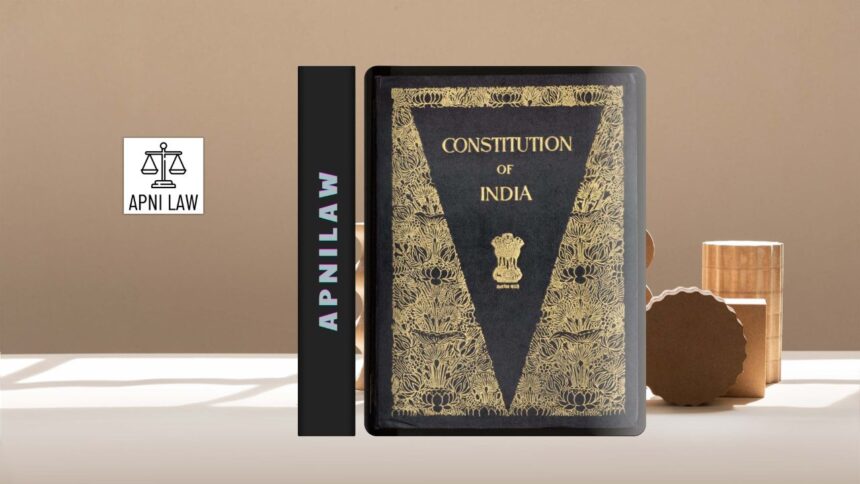Introduction
India’s Constitution stands as one of the most comprehensive and flexible legal documents in the world. It balances federal principles with unitary strength to ensure smooth governance under both normal and exceptional circumstances. Article 354 of the Constitution reflects this flexibility. It empowers the President of India to adjust the financial relations between the Union and the States when an emergency is in force.
Under normal conditions, the Constitution clearly defines how taxes and revenues are distributed between the Centre and the States. This balance is vital for maintaining India’s cooperative federalism. However, during emergencies, ordinary financial arrangements may not work efficiently. In such situations, Article 354 acts as a safeguard. It allows the President to modify financial provisions temporarily to keep the government functioning effectively.
In essence, Article 354 ensures that India’s financial system remains responsive and resilient during crises. It strengthens the Centre’s ability to act quickly while still respecting parliamentary oversight.
Text of Article 354
Article 354(1) – The President may, by order, direct that all or any of the provisions relating to the distribution of revenues between the Union and the States shall have effect subject to such exceptions or modifications as he thinks fit during the period of operation of a Proclamation of Emergency.
Article 354(2) – Every order made under clause (1) shall, as soon as may be after it is made, be laid before each House of Parliament.
Understanding the Article
Article 354 falls under Part XII of the Indian Constitution, which deals with Finance, Property, Contracts, and Suits. The main purpose of this provision is to allow temporary modification in financial distribution between the Centre and the States during a National Emergency declared under Article 352.
In normal times, the Finance Commission recommends how taxes and duties are shared. For example, certain taxes collected by the Centre are divided among the States according to fixed ratios. However, during emergencies like war or national crises, the Union government may require more funds to maintain defense, public safety, or essential services. Article 354 authorizes the President to make those temporary changes without waiting for lengthy constitutional amendments.
Importantly, these modifications are not permanent. Once the emergency ends, the normal system of revenue distribution resumes automatically. This ensures that federal balance is restored after the crisis passes.
Objective and Significance of Article 354
The main objective of Article 354 is financial flexibility during emergencies. Emergencies demand immediate and extraordinary responses, and finances are at the heart of effective crisis management. This provision ensures that the Union government can act swiftly without procedural hurdles.
It also preserves cooperative federalism. The article doesn’t permanently take away the States’ financial rights. It merely pauses or adjusts them to handle extraordinary national challenges.
The importance of Article 354 can be understood through three key aspects:
- Continuity of Government Functions: It ensures that the central and state governments continue to operate smoothly even during national emergencies.
- Swift Financial Action: It enables the Union to redirect funds quickly for national defense, disaster management, or economic stabilization.
- Accountability: Every order made under Article 354 must be presented before Parliament, ensuring transparency and legislative control.
Thus, Article 354 bridges the gap between federal stability and emergency necessity.
How Article 354 Operates During an Emergency
When a Proclamation of Emergency under Article 352 is in force, the President can use Article 354 to modify how taxes and revenues are distributed. For instance, under normal circumstances, the Centre shares certain revenues with the States based on Finance Commission recommendations. But during emergencies, this sharing ratio can change temporarily.
Let’s take an example. Suppose a national emergency is declared due to external aggression. The Centre requires more funds to strengthen defense and provide relief. Under Article 354, the President can issue an order allowing the Union government to retain a greater share of taxes or delay transfers to States. This flexibility ensures that the country’s immediate financial needs are met without legal obstacles.
Once the emergency ends, these changes expire automatically, and normal distribution resumes under Article 280 and related financial provisions.
Connection with Emergency Provisions
Article 354 is closely related to Part XVIII of the Constitution, which deals with Emergency Provisions. It supports the effective implementation of Articles 352, 356, and 360.
- Article 352 – National Emergency
- Article 356 – President’s Rule in States
- Article 360 – Financial Emergency
During a National Emergency, the Union government gains power to legislate on matters listed in the State List (Article 250). Similarly, Article 354 ensures that financial resources align with this temporary shift of legislative power.
In short, Article 354 complements emergency provisions by aligning the country’s financial framework with its constitutional reality during crises.
Difference Between Article 354 and Article 360
Though both deal with financial matters during emergencies, Articles 354 and 360 differ in scope and purpose.
| Aspect | Article 354 | Article 360 |
|---|---|---|
| Type of Emergency | Operates during a National Emergency (Article 352) | Operates during a Financial Emergency |
| Focus Area | Modifies distribution of financial resources between Union and States | Controls government expenditure and salaries |
| Authority | President of India | President of India, based on Cabinet advice |
| Objective | Ensures efficient resource allocation during national crises | Restores financial stability during economic breakdown |
| Duration | Temporary, valid only during emergency | Valid until the financial emergency is revoked |
Thus, Article 354 ensures the Union has flexibility in distributing funds, while Article 360 ensures financial discipline across the system.
Judicial Interpretation and Safeguards
Although Article 354 has not been the subject of direct litigation, the Supreme Court of India has clarified the constitutional limits of emergency powers in several landmark cases.
In Indira Gandhi v. Raj Narain (1975) and Minerva Mills v. Union of India (1980), the Court emphasized that even during emergencies, the basic structure of the Constitution cannot be altered. Federalism, parliamentary democracy, and rule of law remain essential features.
Therefore, Article 354 must operate within those boundaries. It cannot be used to permanently deprive States of financial autonomy or alter the federal balance.
These safeguards ensure that emergency powers are not abused and remain temporary tools for national stability.
Case Illustration
To understand its application, imagine a real-world scenario. Suppose India faces an external war and the government declares a National Emergency under Article 352. Tax revenues drop due to disruption in trade and production. However, defense spending increases drastically.
In such a situation, the President can invoke Article 354 and issue an order that temporarily modifies revenue distribution. The Centre might retain a higher portion of income tax or excise duties for defense expenditure. Once the emergency ends, the President withdraws the order, and normal financial relations resume as per Finance Commission recommendations.
This flexibility ensures that financial administration remains smooth even in the toughest circumstances.
Practical Impact and Relevance
While Article 354 has rarely been invoked directly, its importance remains immense. It serves as a constitutional safeguard that ensures financial preparedness during emergencies.
The 42nd Constitutional Amendment (1976) strengthened the Centre’s power during emergencies, but later, the 44th Amendment (1978) restored some balance to protect the federal spirit. Together, they highlight how India’s Constitution adapts to changing times while maintaining equilibrium between Union strength and State autonomy.
Even though Article 354 may appear dormant in peacetime, it is an essential constitutional mechanism that ensures fiscal continuity and national unity when the nation faces crises.
Conclusion
Article 354 of the Indian Constitution reflects the foresight of its framers. It ensures that India’s financial system remains adaptable, stable, and effective during emergencies. By empowering the President to modify financial distribution temporarily, it provides the Union with the agility to respond to crises without undermining parliamentary control.
At the same time, it maintains the spirit of federalism by restoring normal arrangements once the emergency ends. This delicate balance between flexibility and accountability makes Article 354 a cornerstone of India’s constitutional resilience.
In today’s world, where financial crises, wars, or disasters can strike unexpectedly, Article 354 continues to symbolize India’s ability to remain strong, united, and constitutionally guided through every challenge.
For any specific query call at +91 – 8569843472








